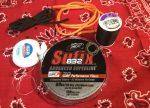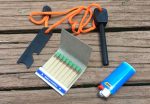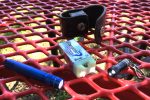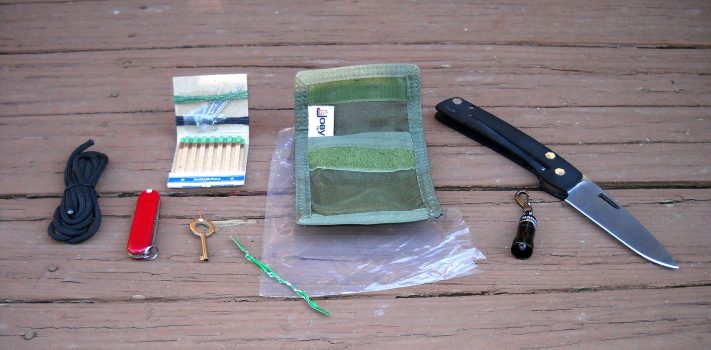(Continued from Part 1. This concludes the article.)
Tool #2: Cordage
Cordage — string, rope, etc. — is another of our oldest tools. Early people would have used animal sinew or plant fibers. No matter what its form, cordage is an essential element for making shelters, tools, and weapons, in first aid, and for making needed repairs.
- Smallest Considered: Dental floss
- Largest considered: Paracord
- Final choice: Paracord, plus several feet of fishing line AND thread
- Honorable mentions: Braided fishline, carpet or upholstery thread
Thread – Strong thread is wonderfully useful for small tasks and repairs, such as attaching a feather to an arrow shaft or repairing torn clothing. I generally choose nylon carpet or upholstery thread, and I look for words like “Extra strong” on the spool label. Thread weighs almost nothing and takes up little room. It can be wrapped around other objects, like a disposable lighter, for easy carry. Wax it with beeswax to repel water and to reduce tangling. Its failing is its limited strength, which makes it inadequate for such necessary tasks as shelter building, but its tiny size, feather weight and general usefulness makes thread something that belongs in a kit whenever possible. Add a needle or two for even more versatility. I wrap several feet of thread around a matchbook cover, with two or three needles. Highly recommended.
Braided Fishing Line – A little thicker than the thread, but much stronger and more abrasion resistant, braided line for fishing can be very, very useful. It’s much easier to use than old-style monofilament: braided fishing line is an excellent choice for a variety of projects, including the repair of web gear, packs and other hard-use items, yet it wraps around a lighter or a matchbook cover, just like thread. It also benefits from waxing with beeswax. I like to wrap both thread and fishing line around a matchbook cover, with a few needles, to cover a wide variety of repairs and tasks.
 Paracord – Parachute cord, generally known as paracord or 550 cord, is strong, as well as being resistant to rot. Military paracord consists of seven two-ply nylon strands, encased in a braided outer shell. Don’t get the cheap stuff that is sometimes sold in craft stores. It lacks the core made up of strands and is not as strong as real paracord. Good paracord is like duct tape: useful for almost anything! It can be used in rigging up a shelter, as an improvised tourniquet, or for making or repairing tools or weapons. Additionally, the inner strands can be pulled out to use in smaller jobs, while the braided shell can be used as replacement shoelaces or for other tasks. I usually carry three feet of paracord (which weighs 0.2 ounces), but I’d prefer 5-6 feet, or even more. It’s hard to have too much paracord.
Paracord – Parachute cord, generally known as paracord or 550 cord, is strong, as well as being resistant to rot. Military paracord consists of seven two-ply nylon strands, encased in a braided outer shell. Don’t get the cheap stuff that is sometimes sold in craft stores. It lacks the core made up of strands and is not as strong as real paracord. Good paracord is like duct tape: useful for almost anything! It can be used in rigging up a shelter, as an improvised tourniquet, or for making or repairing tools or weapons. Additionally, the inner strands can be pulled out to use in smaller jobs, while the braided shell can be used as replacement shoelaces or for other tasks. I usually carry three feet of paracord (which weighs 0.2 ounces), but I’d prefer 5-6 feet, or even more. It’s hard to have too much paracord.
Dental Floss – Floss can be used for many of the same tasks as thread, but I especially like the waxed varieties: they are easier to handle than non-waxed floss. One summer while teaching archery, I used floss to make a nocking point on a bowstring, and it lasted through many days of shooting. The dispenser that floss is sold in is convenient but too large. Discard the dispenser and wrap the floss around something, like a lighter or a flashlight. It’s an old-school choice that’s cheap and widely available, but it still works!
Tool #3: Fire-making Tools
 There are many ways to make fire, all with advantages and disadvantages. Among the most popular are matches, a disposable butane lighter, or a ferrocerium rod. The most important component in fire making, however, is plenty of practice. You won’t learn the skill of fire making on the night when it’s raining, windy and your hands are shaking with cold.
There are many ways to make fire, all with advantages and disadvantages. Among the most popular are matches, a disposable butane lighter, or a ferrocerium rod. The most important component in fire making, however, is plenty of practice. You won’t learn the skill of fire making on the night when it’s raining, windy and your hands are shaking with cold.
Whichever tool(s) you use to light it, fire is an essential element of survival. Its heat is a defense against hypothermia. It can be used to boil water and to cook food. By adding green leaves and branches to a fire, you can make smoke to signal during the day, and the light of a fire can be seen for miles at night. The light of a fire illuminates a campsite, and it can keep your spirits up.
- Smallest Considered: Paper matches
- Largest considered: Disposable butane lighter
- Final choice: Paper matches
- Honorable mention: Ferrocerium rod
Paper matches – My choice is a book of paper safety matches, in a plastic bag that is closed with a twist tie. They are very small and weigh only 0.2 ounces, yet they are easy to use and safe to carry. I’ve found safety matches to have a longer shelf life than strike-anywhere matches. They are easier to use successfully with cold, shaking hands than a ferro rod and scraper, and they can’t be accidentally drained like a butane lighter.
Strike-anywhere matches – Wooden, strike-anywhere matches are a classic piece of kit, but I’ve found them wanting on multiple occasions. One problem is that most of us who carry strike-anywhere matches assume there’ll be a striking surface nearby. Try that in a rainstorm in the woods. Finding a dry surface to light a match can be tough under those conditions. Another issue I have is their bulk. A wooden match burns longer than a paper match, but paper matches take a lot less space, and I always have a striking surface. As mentioned before, strike-anywhere matches do have a shelf life. If you choose to carry them, I suggest occasional testing and replacement to make you have matches that work when they’re needed.
Disposable lighter – A small, disposable butane lighter is an excellent choice, if you have a way to keep it protected to minimize its chance of being empty when you need it. The lighter can start far more fires than any type of matches you might carry, and it is still useful when empty because its wheel throws fairly hot sparks. All this with a weight of just 0.2 ounces and length of 2.4 inches! As insurance, though, you can cut a book of matches in half, seal it in plastic, and have a very compact backup to your lighter.
Ferrocerium rods – The “ferro” rod, along with a steel scraper or the back of a knife blade (usually filed to give the spine a sharp corner for scraping), can throw large, very hot sparks for fire starting. This is a great tool that is small enough to consider for everyday carry. Its drawbacks are weight — the rod in the photo weighs 1.1 ounces by itself — and the need for practice. If you choose a ferro rod, buy at least two: one as a learning tool and the other for carry. You need practice using a ferro rod to start a fire in real-world conditions.
Tool #4: Light
 A good light can be a lifesaver. It can help you find your way, illuminate a vital task, or can be used to signal for help. Some readers may already carry a flashlight, in which case a small light as a spare may be a good idea. If your daily carry light is a “tactical” model, you may wish to choose a second light with less power but a much longer run time.
A good light can be a lifesaver. It can help you find your way, illuminate a vital task, or can be used to signal for help. Some readers may already carry a flashlight, in which case a small light as a spare may be a good idea. If your daily carry light is a “tactical” model, you may wish to choose a second light with less power but a much longer run time.
- Largest considered: Pak-Lite Super 9v
- Smallest considered: Streamlight Nano
- Final choice: Streamlight Nano
- Honorable mention: MagLite LED Solitaire
Pak-Lite Super 9v – Pak-Lite flashlights are tiny LED lights that attach to a 9 volt battery. With a lithium 9v battery, the Pak-Lite Super can provide over 1,000 hours of light on the low setting and about 80 hours on the high setting. This is my daily carry flashlight, which is protected and kept handy in a small belt pouch I made for it. I use a lithium battery for long life and light weight (1.4 ounces). The Pak-Lite is not waterproof, so I keep it in a plastic bag in wet conditions. I also wrap a little bit of clear tape around the connection of light and battery, to keep them together if the light is dropped. Learn more at: https://www.9voltlight.com/home
MagLite LED Solitaire – This is an updated version of the classic MagLite Solitaire. The LED lamp gives much better battery life — rated at 37 lumens with a 1 hour, 45 minute run time — and is a very good little light at a modest price. The tough little LED Solitare is 3.19 inches in length, weighs just .85 ounces and runs on a single AAA battery.
Streamlight Nano – At 1.47 inches in length and .36 ounces, the Nano is truly tiny and uses four IEC-LR41 alkaline coin cells for power. A small snap hook lets you attach it to clothing, keys, etc. I chose it as a very small, water resistant backup to my Pak-Lite Super.
Other Items
You may choose to add other items to your kit to add further capabilities. Some categories of items that could be added include:
- Medical supplies, such as a tourniquet, Israeli bandage, etc.
- Cash
- Pencil or pen, and paper
- Communications: Whistle, Contact list
- Plastic bag or condom for carrying water
- Fishing kit: hooks, monofilament, split shot
Conclusion
Your EDC kit will probably evolve over a period of time, as you have the opportunity to use the items and gain a better understanding of what is useful to you. Just remember to replace any components that are used or which need to be refreshed or changed out. Never forget, however, that the purpose of the kit is to expand your options for dealing with an emergency without being bulky enough to be left behind. Whatever gear you choose for your micro survival kit, know how to use it, and carry it! It will do you no good at all if it isn’t with you when needed.










